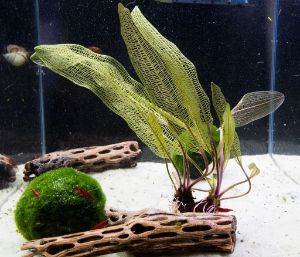
Madagascar Lace Plant (Bulb) Aponogeton madagascariensis is considered by many to be the holy grail of freshwater aquarium plants

photo credit: Aquatic Arts
There are many who consider the Madagascar lace plant to be the pinnacle of freshwater aquarium vegetation. Its long, round leaves resemble a web or netting and have been called "skeletal." This plant has the potential to reach a height of over 20 inches, making it a prime candidate for the spotlight in any freshwater aquarium. Although not a "beginner plant," it requires less attention than its notoriety would suggest. More information about its requirements for care has become available in recent years, which has improved the success of hobbyists with this plant.
The Madagascar lace plant, like other Aponogeton bulbs, needs a "resting phase" to keep going for a long time. Most or all of its leaves will fall off at this time. Many people probably just threw away their plants because they thought they were dead before this phase was even recognized. However, with proper care, new leaves will emerge from the bulb a few weeks after the resting period ends, often expanding and becoming fuller than they were before.
The Madagascar lace plant bulb, in contrast to the Aponogeton bulbs that must be kept cold or even outside the aquarium in a damp container, should be kept submerged and partially buried in the substrate. Furthermore, it has a peculiar requirement for higher temperatures during its dormant phase. If the soil around the bulb is kept moist and fertile, new leaves will sprout. The Madagascar lace plant prefers cooler temperatures and constant moderate to high water flow outside of its summer dormant period.
Seachem Flourish, Flourish Excel, Nitrogen, and other plant supplements are beneficial for the Madagascar Lace Plant, as they are for most plants.

References
Asian Liverwort (Monosolenium tenerum) is a rare, but very popular and attractive species of liverwort for the freshwater aquariumBaby Tears (Hemianthus micranthemoides) A small and vibrantly green plant that requires medium to high lighting
Banana Plant (Nymphoides aquatica) is a rosette plant that is named for its large and highly unique roots
Brazilian Pennywort (Hydrocotyle leucocephala) is a very fast-growing and low-maintenance plant with leaves that closely resemble lily pads in shape and color
Chrismas Moss Xmas Moss for Sale (Vesicularia montagnei) is a rare, but very popular and attractive species of creeping moss for the freshwater aquarium
Coral Moss or Mini Pellia Mat for Sale (Riccardia chamedryfolia) is a rare liverwort from Southeast Asia
Geppi Moss (Fissidens geppi) is a very rare Asian aquatic moss that is occasionally available for the freshwater aquarium
Giant Marimo Moss Balls are widely kept as ornamental plants in jars
Indian Water Fern (Ceratopteris thalictroides) This lovely plant is extremely low-maintenance and easy to grow, making it a great choice for beginner aquarium hobbyists
Java Fern (Microsorum pteropus) is a very popular plant in the aquarium hobby due to its impressive size
Lacy Java Fern (Microsorum pteropus Windelov) this aquatic plant was cultivated from and shares many characteristics with the original Java Fern plant
Madagascar Lace Plant (Bulb) Aponogeton madagascariensis is considered by many to be the holy grail of freshwater aquarium plants
Moneywort (Bacopa monnieri) Moneywort is a popular stem plant that grows quickly and has exceptionally bright green leaves
Phoenix Moss (Fissidens fontanus) This plant is a very fluffy, lush green plant that will attach to most surfaces and can eventually grow into a large mat of impressive size
Rotala indica is a favorite of many planted-aquarium enthusiasts due to the way it adds color and depth to any aquarium in which it is placed
Subwassertang is a great plant to keep in any freshwater aquarium due to its low lighting requirements
Water Wisteria (Hygrophilia difformis) is a surprisingly attractive, yet hardy and undemanding plant that is ideal for the larger aquarium




